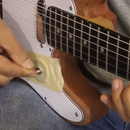Introduction: Laser Fume Extractor Filter
If you purchased a laser cutter, you'll need some sort of fume extraction. While many come with a powerful fan that works well, if you would prefer not to vent an excessive amount of smoke into the atmosphere, then check out this simple build made with scrap particle board. While certainly not the best filter setup available, it is easy to make, involving 3/4 inch particle board and 3D-printed adapters.
Disclaimer: This filter setup is fairly easy, and eliminates the majority of smoke from a 60W laser cutter. However, I don't know its filtration efficacy and should never be vented to indoor air. Always pipe it outside. If you try these methods, it is at your own risk.
Step 1: Build Video:
Video shows how it was built, as well as initial testing. Update further down, adding activated carbon.
Step 2: Materials
This can be built to suit your needs and available materials, but the important thing is that there's an adapter for your inlet and outlet hose, as well as a place to set the HVAC filter. I used:
- Scrap 3/4 inch MDF
- Glue
- 3D-printed inlet/outlet adapters
- 3D-printed "air ramp" (optional, but should improve air flow.
A variety of adapters and the ramp are found here on GitHub.
Consumables:
Step 3: Glue Box Together
Sizing will depend on your particular setup (mine was ~15 inches high and ~13 inches square), cut or source, and glue the box up so that your selected filter fits inside against the inside "spacer" walls.
- The inside walls should line up flush with the filter, forming a close-to-seal which causes the vast majority of air to flow through.
- Ensure removable "hatch" portion lines up well, and sand as necessary, so that it forms an almost-seal to help suck fumes. One could also consider making a gasket of some sort and/or using a clamp.
- Cut holes in the top and side for hose adapters using a jigsaw or other means, and hot glue them to seal in place.
Step 4: Activated Carbon Update
After not too long using this, I noticed that it was actually putting out a lot of smoke. Whether this was because the filter was saturated, or I was using a dirtier material, or some combination, I'm not sure. My solution was to simply place 6 bags of activated charcoal on top of the filter to absorb more of the smoke.
This appears to work quite well so far, but as noted earlier, still exhaust the output to the atmosphere.
Notably, the suction setup here seems to be a good solution, as it's attempting to keep the box sealed, not pushing on it, as it would be if the filter was positioned after the blower. Secondly, having the air somewhat purified before the blower means that there should be less gunk buildup there. Win-win!
Hope this gives you some ideas. I'll be putting up some laser stuff on my "Laser Cook" YouTube channel, so I'd invite you to check that out and subscribe if you're interested!
*Note that Amazon links are affiliate!













